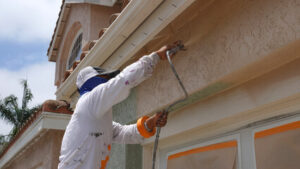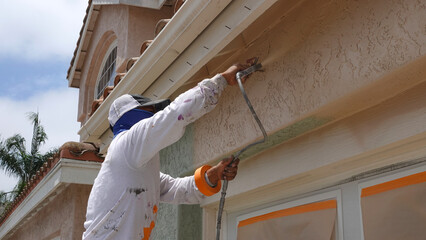Stucco Repair involves more than simply patching cracked stucco. Stucco Repair Philadelphia also includes diagnosing and correcting the underlying issues that caused it to crack. Check for loose stucco by tapping on the wall with a wood or acrylic hammer. Loose stucco sounds spongey and may feel soft to the touch.
 Cracks in stucco are a common problem that can occur in any construction. Some of these cracks are cosmetic and easy to repair, while others can indicate structural issues that must be addressed before you can rely on your stucco to prevent further damage. A common test that you can use is to slide the edge of a credit card into the cracks to see how wide they are. Cracks wider than this should be treated with more urgency as it may indicate that there is some structural damage that needs to be addressed before you can expect your stucco to remain stable.
Cracks in stucco are a common problem that can occur in any construction. Some of these cracks are cosmetic and easy to repair, while others can indicate structural issues that must be addressed before you can rely on your stucco to prevent further damage. A common test that you can use is to slide the edge of a credit card into the cracks to see how wide they are. Cracks wider than this should be treated with more urgency as it may indicate that there is some structural damage that needs to be addressed before you can expect your stucco to remain stable.
Hairline cracks aren’t as serious as deep cracks but can provide a pathway for moisture and water entering a wall system. This can lead to swollen and softened drywall, wood rot and other problems. Moisture penetrating through a wall can also cause stains on the underlying drywall and baseboard. If you don’t find and correct the underlying issue that is causing the moisture penetration then it won’t matter how many times you patch these cracks in your stucco as they will continue to appear.
To patch cracks in your stucco, you will need to apply a thin layer of mud over the damaged area. This first coat is called the scratch coat and it is used to help future layers adhere to the stucco. This can be accomplished with a hand float or a notched trowel. You will want to make sure that the scratch coat is smooth and even with the surrounding undamaged areas of your stucco. Once the scratch coat has dried you will want to brush it well and apply a brown coat that is color-matched to your existing stucco.
If you notice that your stucco has changed colors over time, you will need to buy some pigment and mix it into the brown coat to match the color of your existing stucco. Once this is done, you can brush and wet the brown coat again and apply a finish coat to match your existing stucco.
Water Damage
Stucco is a beautiful and durable material that stands up to the weather conditions of our Thousand Oaks neighborhoods. Unfortunately, like many masonry materials it can be susceptible to moisture problems and if these are not caught early enough, they may lead to cracking, staining, deterioration or even leaks. The best way to keep your stucco looking fresh is to have a professional contractor inspect it regularly and make repairs as needed.
The most common sign of a water problem in stucco is staining. Staining usually appears as white hazy streaks or dark blotches in the paint color. While many homeowners will just repaint the stained area, the truth is that it is a sign of a bigger problem. When left untreated the staining can progress to efflorescence or blistering. Blistering is when the surface of a masonry wall turns white or powdery due to the expansion of salts that were dissolved by the seeping moisture. Eventually the blistering can also cause the wood ledgers to rot which then allows water to seep through and damage the entire wall system.
Many homeowners mistakenly believe that stucco is covered by homeowner’s insurance when it comes to moisture issues. This is not always the case, but it depends on a few different factors including what kind of moisture damage was caused and if the problem is a result of poor installation.
To get an accurate assessment of whether your stucco needs repair, a contractor will use a moisture meter to determine the level of moisture within the wall cavity. This involves drilling a series of holes into the suspected areas and inserting a small probe to read the moisture content of the surrounding stucco. This method is far more accurate than simply visual inspection or using thermal imaging to sense warmer and cooler areas on the surface of your stucco.
When a home is experiencing major moisture problems, the first step in fixing the issue is often to remove the affected portion of the stucco. A skilled contractor will then apply a premixed stucco patching product to the area with a putty knife. Depending on the texture of your stucco, it may be necessary to add a sanded caulk in order to ensure that the patching blends in seamlessly with the rest of the wall. After patching, the damaged area will be painted to match the color of the existing stucco.
Moisture Penetration
Stucco is an excellent cladding solution to protect the walls of your home, but like any material it needs proper drainage and moisture management to function properly. When a stucco wall is not well managed, it can become damaged very quickly. While there are many reasons why stucco can crack and break, moisture penetration is a common culprit. Moisture intrusion can lead to structural damage, mold and rot in framing members, and even damage to interior structures.
Traditional stucco requires a combination of Portland cement, sand, and lime to create its weather-resistant surface. While modern building products such as EIFS (electronic insulation foam) are becoming more popular, traditional stucco still has a place in the industry, but it must be properly maintained and repaired to avoid water damage.
Moisture penetration in stucco typically occurs at the joints, around openings such as doors, windows and electrical fixtures, and the corners of the house. When these areas are not properly flashed and sealed, moisture can seep into the underlying water resistant barrier and cause damage to the drywall and sheathing.
The best way to prevent moisture penetration is to have a qualified and experienced contractor properly install the flashing at these points in your home. This includes installing a kick-out flashing on roof rakes that intersect walls and pan flashing with end dams at all window sills and head assemblies.
You should also pay attention to your window caulking and look for gaps or cracks. If these are found, you should have them replaced as soon as possible to keep moisture from entering your home. Additionally, you should pay close attention to the moisture readings on your home’s walls and be sure to monitor them after a rainstorm. A damp looking stucco after a rainstorm is normal, but if it remains wet for a week or more after a rainstorm, this could be a sign of water infiltration. You should also be on the lookout for dark streaks on your stucco that never seem to disappear. These are all signs that it is time to call a professional for stucco repair.
Mold
Stucco adds character, charm and beauty to buildings and residences, but it needs care over time. Mold, mildew and other staining can eat into stucco and affect the overall look of a building. Mold is especially problematic if it penetrates beneath the surface of your home’s exterior wall. If left unchecked, it can rot the wood framing and other portions of your house’s structure. Mold is also a health risk and it’s best to have any mold spots inspected by a professional.
To prevent mold from penetrating into stucco, it’s important to keep the walls clean. Wash them frequently with diluted dish soap and water to remove dirt, dust and other organic material that can cause mold to grow. In addition, make sure that plants are trimmed and away from the building’s walls to avoid moisture build-up.
If you spot mold in your stucco, it’s important to take steps to have it removed as soon as possible. A professional will be able to diagnose the problem and repair it before it worsens. It’s also a good idea to call a professional for a moisture inspection before you start repairing the walls. A professional can let you know if water damage is present, which can help you decide whether to repair the stucco or replace it entirely.
The most common place to see mold on a stucco structure is on the underside of the wall. This is because of the porous nature of the stucco and because it provides a perfect hiding place for mold to hide in and grow. Mold can also get between the exterior stucco and the framing of your home, which can rot the wood and create serious structural problems.
To fix this problem, a professional will scrape the mold off and then apply an anti-mold coating to the surface of your stucco. This will help to prevent the mold from growing back in the future and keep it from resurfacing in other areas of your home.
If the mold is a deeper issue, a professional will need to examine the condition of the wood framing and other structures behind your stucco. This is because if the wooden beams are rotting, they can weaken the stucco and cause it to eventually collapse.
